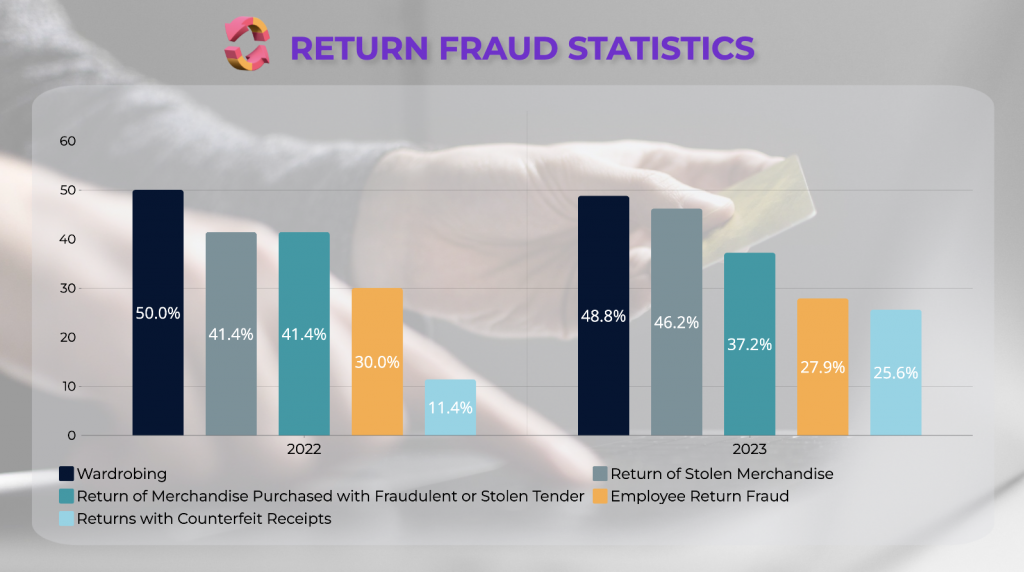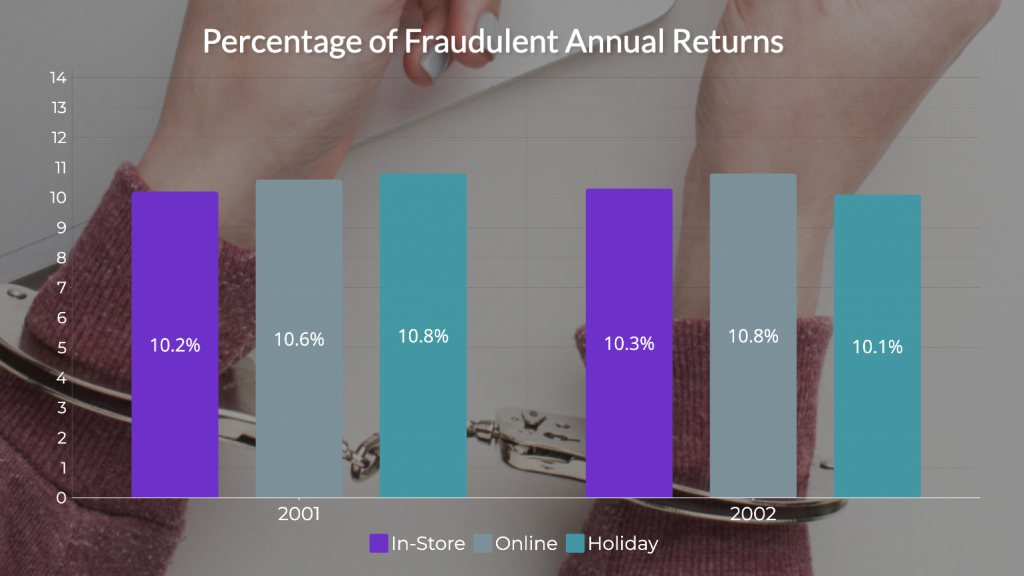In 2023, retail returns totaled $743 billion in the US, approximately 14.5 percent of all retail sales that year. Additionally, about 14 percent of all returns are fraudulent. As retail fraud continues to rise, business owners are implementing various strategies to help combat and reduce the effects of the loss.
Table of content
Continue reading to learn more about return fraud and essential strategies to safeguard your business against it:
Knowing the Basics

What is Return Fraud?
Return fraud occurs when customers intentionally abuse the merchant’s return policy, often involving returning an item that does not qualify for a return or refund. Return fraud is one of the most common retail fraud typologies and occurs both in-store and online. Common return fraud may include the return of the following:
- Stolen merchandise
- Items from a different retailer
- Counterfeit items
- Items that have been used
What Distinguishes Return Fraud from Refund Fraud?
Though both impact a business’s profit margin, there is a difference between return fraud and refund fraud. Return fraud centers around customers taking advantage of the business’s customer-friendly return policies. Refund fraud occurs when the customer makes false claims about their purchase to receive a refund without returning the item.
Revenue is lost from both fraudulent acts. The business’ accounts are down from the initial sale in a return fraud transaction, and money is lost from any potential resale in the event of refund fraud.
What is an example of refund fraud?

There are several types of refund fraud, and they can occur with any business. For example, if a customer buys an expensive outfit to wear to a special event and then returns it with the tags still attached after wearing it, the reason for the return is that the outfit didn’t fit. Because it still has the original tags, the retailer accepts the return, even though it was already worn.
Identifying the Issues

Types of Return Fraud
There are different types of return fraud examples retailers have experienced in previous years. Below is a chart of the most common types of return fraud and the percentage of businesses that experienced it in 2022 and 2023:
| Type of Return Fraud | 2022 | 2023 |
| Wardrobing | 50% | 48.8% |
| Return of Stolen Merchandise | 41.4% | 46.2% |
| Return of Merchandise Purchased with Fraudulent or Stolen Tender | 41.4% | 37.2% |
| Employee Return Fraud | 30% | 27.9% |
| Returns with Counterfeit Receipts | 11.4% | 25.6% |

Return fraud is often challenging to detect because there are many tactics deceitful consumers use to carry out their schemes. Continue reading to discover more about the different types of return fraud:
Wardrobing
Wardrobing is a type of fraud in which the consumer buys an item and uses it once. After using the item, the consumer returns it for a refund or exchange. Many consumers see nothing wrong with this action, making it one of the most common return fraud transactions.
Price Switching
Price switching occurs when the customer buys an item at one price and, before returning it, swaps the price tag with a more expensive item. Upon returning the item, the customer requests a full refund for the higher price. Price switching is more prevalent in brick-and-mortar stores.
Opportunistic

An opportunistic fraudulent return can happen when the consumer deliberately or unwittingly claims the wrong reason for a return. In most cases, this type of return is not pre-meditated because consumers are unaware that selecting the incorrect return reason affects the merchant.
Bricking
Bricking is most common in electronic device returns and occurs when the buyer returns the item after removing the valuable parts. In most bricking incidents, the fraudster resells the removed parts for profit while also keeping the refund issued by the merchant for the returned item.
Seller Sabotage

Seller sabotage occurs when someone buys items from a competitor and returns them as late as possible according to the return policy. This fraudulent action depletes the competitor's inventory to draw new customers to a store that has the items in stock. In some cases, counterfeit items are returned in place of the items to damage a competitor's reputation.
Returning Items from a Different Retailer
If a retailer allows no receipt returns, consumers can purchase an item from a different retailer and, if they cannot return it to the original location, bring it to a store that will accept the return.
Counterfeit Returns

Counterfeit returns do not only occur with seller sabotage; they can occur with any store that sells easily counterfeited items. They occur when the buyer returns a counterfeit item in exchange for the authentic item they previously purchased.
Counterfeit Receipts
Some stores have easily duplicated or created counterfeit receipts, allowing items never purchased at the retailer to be returned with no questions asked.
Stolen Merchandise Return

Stolen merchandise returns are a form of fraud when the fraudster returns items they stole from that location or another location. Sometimes, merchandise is purchased using counterfeit money or a stolen credit/debit card and later returned for a refund. When using a credit/debit card, the fraudster typically tries to get cash back or the money returned on a card, which differs from what was used for the original transaction.
How common is return fraud?
Return fraud is uncommon, but the percentage of fraudulent returns has increased. It is estimated that 13.7 percent of returns are fraudulent, with a higher percentage of return fraud during the peak holiday season at 16.5 percent.
| Sales | Returns | Fraudulent Returns | |
| Annual | $5.13 trillion | $743 billion | $101 billion |
| Holiday | $966 billion | $148 billion | $24.5 billion |
Recognizing the Impact

What are the consequences of return fraud?
Return fraud carries severe consequences for both the perpetrators and the retail business. Though it may be challenging to prove return fraud, the perpetrator could face significant penalties if proven. Those who commit return fraud could face criminal charges, fines, and imprisonment if caught.
For business owners, there is the expensive cost of dealing with return fraud and financial loss of up to three percent of their annual revenue. In addition to economic loss, business owners must account for wasted time, administration fees, and shipping costs for online orders. The amount of money, time, and resources lost increases significantly when dealing with a repeat offender.
Return Fraud Rates
Return fraud rates have increased from 10.4 percent in 2022 to 13.7 percent in 2023. Fraudulent returns reached more than $102 billion in 2023, up approximately 20 percent from $85 billion in 2022.
Below is a chart showing the percentage of fraudulent annual returns to retailers in 2021 and 2022:

| Year | In-Store | Online | Holiday |
| 2021 | 10.2% | 10.6% | 10.8% |
| 2022 | 10.3% | 10.8% | 10.1% |
Implementing Detection and Prevention Strategies

Return Fraud Detection Strategies
Being able to detect when a return is fraudulent is vital to preventing excessive loss and damages associated with this deceptive practice. Retailers can implement innovative solutions to help detect return fraud in real-time, stop fraudsters in their tracks, and deter future attempts at fraudulent returns. Some measures retailers can implement to detect return fraud proactively may include the following:
- Use analytics to identify anomalistic behavior, which could be an indicator of fraud
- Analyze past return fraud data to identify patterns and red flags
- Educate staff about different ways to recognize the red flags associated with return fraud
- Educate staff to identify what a normal versus abnormal return looks like quickly
How do I stop return fraud?

Once the fraud has occurred, little can be done outside of reporting the buyer to the authorities, alerting employees about the buyer, and refusing future returns made by the same buyer. However, there are some things you can do to stop return fraud before it occurs.
Some things you can do as a retailer to prevent return fraud may include the following:
- Have a strict return policy in place and stick to it
- Educate customers about your return policy
- Require a photo ID and contact information for returns
- Do not offer cash refunds instead offer store credit
- Issue gift receipts to help customers make returns they receive as a gift
- Only offer refunds on returns in the same manner as the original purchase was made
- Conduct random audits to identify trouble areas of your policy
How can you protect against return fraud?

The best way to protect your business against return fraud is to have a good return policy and adhere to all the specifics stated within. Allowing customers to return items gives them more confidence when buying from you. Still, it also gives you a sense of security knowing your return policy will help protect your business against fraudulent returns.
Other ways to help protect your business against return fraud may include the following:
- Establish clear holiday return policies
- Receipts - issue them with every sale and require them for a return
- Use 360 ID Tags to identify when a product has been used or worn
- Add restocking fees
- Do not send pre-packaged return labels with the order
Return fraud negatively impacts retailers in many ways, affecting their profits and how they can efficiently conduct business. Establishing a comprehensive return and refund policy and other protective measures can help reduce the amount of fraudulent returns you receive. Take time to look at your return policy and identify where your business can improve in how it handles returns and fights against fraud.
The responses below are not provided, commissioned, reviewed, approved, or otherwise endorsed by any financial entity or advertiser. It is not the advertiser’s responsibility to ensure all posts and/or questions are answered.




